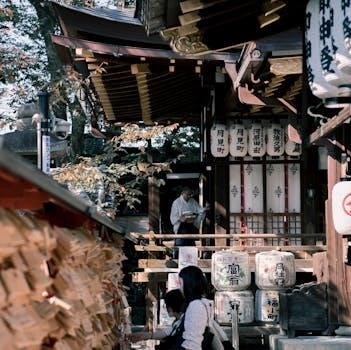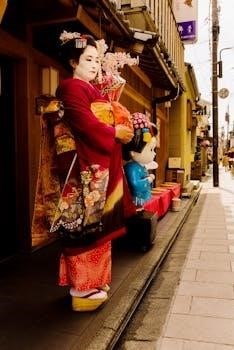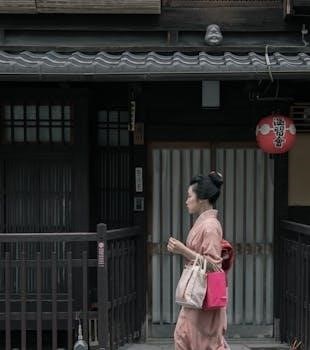Executive Order 9066
Issued on February 19, 1942, by President Franklin D․ Roosevelt, this order authorized the forced removal of Japanese Americans from the West Coast to inland relocation centers․ It was presented as a national security measure․
Issuance and Purpose of the Order
Executive Order 9066, signed by President Franklin D․ Roosevelt on February 19, 1942, was the directive that initiated the mass relocation of Japanese Americans․ The official justification cited national security concerns following the attack on Pearl Harbor, creating a climate of fear and suspicion towards individuals of Japanese ancestry․ This presidential order granted military authorities the power to designate areas from which any person could be excluded․ In effect, it authorized the establishment of military zones and the forced removal of people from these areas, with the primary target being the West Coast․ The order made no distinction between citizens and non-citizens, thus impacting both American-born Japanese and immigrants․ It set in motion a series of events that would lead to the internment of over 120,000 people, demonstrating a significant and rapid shift in governmental policy․ The stated purpose was to prevent potential espionage and sabotage, but its application was indiscriminate and based solely on ethnicity․
Forced Relocation of Japanese Americans
Following Executive Order 9066, approximately 120,000 Japanese Americans, two-thirds of whom were native-born citizens, were forcibly removed from their homes on the West Coast․ These individuals were given short notice and minimal time to prepare, often having to sell their property and businesses at great losses․ They were instructed to report to assembly centers, often temporary locations such as racetracks and fairgrounds, before being moved to more permanent inland internment camps․ The relocation process was traumatic and disruptive, uprooting families and communities with little regard for their personal circumstances or civil rights․ This mass removal was carried out by military authorities and involved considerable logistical planning to transport such a large population to remote, often hastily constructed facilities․ The forced relocation deeply impacted the lives and well-being of those affected, leaving lasting scars on individuals and communities․ These actions were a clear violation of civil liberties․

Internment Camps
These were inland facilities operated by the military, where Japanese Americans were confined․ They were required to evacuate their homes and businesses, regardless of U․S․ citizenship․
Operation of Inland Camps
The inland camps were established in remote locations, often in harsh environments, and were managed by the War Relocation Authority․ These camps were designed to hold Japanese Americans who were forcibly removed from their homes on the West Coast․ The camps were guarded, and residents were not allowed to leave without permission․ Life in these camps was tightly controlled, with set schedules for meals, work, and other activities․ Residents were often assigned tasks such as farming, sewing, and other manual labor․ The camps were meant to be self-sufficient, but resources were often scarce․ The military oversaw the overall operation and security of the facilities․ Despite the restrictions, Japanese Americans tried to establish some semblance of community life within the camps, organizing schools, religious services, and recreational events․
Life in the Camps
Life within the internment camps was characterized by hardship and a lack of freedom․ Families lived in cramped barracks, often with little privacy․ The camps were often located in desolate areas with extreme weather conditions, making daily life difficult․ Despite these challenges, Japanese Americans worked to create a sense of community․ They established schools, churches, and community centers to maintain their culture and traditions․ Residents faced constant uncertainty and anxiety about their future, and were concerned about their homes, businesses, and livelihoods left behind․ Even though they were incarcerated, many tried to maintain a positive attitude and hoped for a return to normal life․ The experience deeply affected many individuals and families․

Constitutional Challenges
The forced relocation and curfew orders faced legal challenges from Japanese-American citizens․ These individuals contested the constitutionality of these actions, arguing they violated their civil liberties․
Legal Actions by Hirabayashi, Korematsu, and Endo
Three Japanese-American citizens, Gordon Hirabayashi, Fred Korematsu, and Mitsuye Endo, each took legal action against the government’s orders․ Hirabayashi challenged the curfew imposed on Japanese Americans, arguing it was discriminatory․ Korematsu challenged the exclusion orders that led to forced relocation, asserting they violated his rights․ Endo’s case focused on the legality of the internment itself, as she sought release from the camps․ These three cases became landmark legal battles that questioned the constitutionality of the actions taken against Japanese Americans during World War II․ Their bravery in challenging the government paved the way for future discussions on civil liberties and equal protection under the law․ They each endured personal hardships and social stigma to fight for their rights․ These cases highlighted the complex legal issues surrounding the government’s power in times of war․
Supreme Court Decisions
The Supreme Court addressed the cases brought forth by Hirabayashi, Korematsu, and Endo․ In Hirabayashi v․ United States (1943), the Court upheld the curfew order, citing national security concerns․ Then, in Korematsu v․ United States (1944), the Court also upheld the exclusion order, again emphasizing military necessity․ These decisions effectively legitimized the government’s actions, despite arguments of racial discrimination․ However, in Ex parte Endo (1944), the Court ruled that the government could not detain a citizen whose loyalty was established, leading to the release of some internees․ Despite some success, these decisions are now viewed as a dark stain on the court’s history, as they sanctioned the violation of civil liberties of a specific racial group․ The court’s rulings have been widely criticized for failing to protect the rights of Japanese Americans․

Impact and Legacy
The internment resulted in the violation of civil liberties for over 120,000 Japanese Americans․ This period caused long-term emotional, economic and social damage to the community, leaving lasting scars․
Violation of Civil Liberties
The forced relocation and internment of Japanese Americans during World War II represented a profound violation of their civil liberties․ These individuals, many of whom were American citizens, were deprived of their fundamental rights, including freedom of movement, due process, and protection from discrimination․ They were forcibly removed from their homes and businesses based solely on their ancestry, a clear example of racial profiling․ The internment camps, often hastily constructed and located in remote areas, lacked adequate living conditions and restricted personal freedoms․ This act demonstrated a disregard for the constitutional rights of Japanese Americans and left a lasting scar on American ideals of justice and equality․ The government’s actions were driven by fear and prejudice, rather than any actual threat posed by the Japanese American community․ This chapter in history serves as a critical reminder of the fragility of civil liberties during times of national crisis and the importance of safeguarding the rights of all individuals, regardless of their background․
Long-Term Effects on Japanese Americans
The internment experience left deep and lasting scars on the Japanese American community․ Beyond the immediate trauma of displacement and confinement, many faced significant economic losses, having been forced to abandon their homes, businesses, and farms․ The psychological impact of the internment was profound, with many individuals and families suffering from anxiety, depression, and a loss of trust in the government․ The stigma of being labeled as an “enemy alien” continued to affect Japanese Americans for generations, leading to social isolation and discrimination․ The internment also disrupted family structures, with children growing up in the camps and losing connection to their cultural heritage․ Despite these hardships, many Japanese Americans demonstrated incredible resilience and fought for recognition of their rights and an apology from the government․ Their story serves as a testament to the enduring strength of the human spirit and the importance of learning from past mistakes․

Historical Interpretations
The internment of Japanese Americans during World War II has been subject to various interpretations․ Some view it as a necessary wartime measure, while others see it as a grave injustice and violation of civil liberties․
Revisionist Views on Internment
Some revisionist interpretations attempt to justify the internment of Japanese Americans by emphasizing the perceived threat of espionage and sabotage, citing the attack on Pearl Harbor as a catalyst for such actions․ These views often downplay the lack of concrete evidence linking Japanese Americans to any disloyalty, and ignore the widespread anti-Japanese sentiment that fueled the decision․ Revisionist arguments also tend to focus on the wartime context and the need for national security, minimizing the immense human cost and suffering endured by those incarcerated․ Such perspectives often present the internment as an unfortunate but necessary wartime measure, rather than a violation of civil liberties․ They may also emphasize the government’s supposed concern for the safety of Japanese Americans, framing the internment as a protective measure rather than a discriminatory one․ This interpretation often neglects the fact that many Japanese Americans were American citizens, thereby undermining the very principles of equality and justice that the United States claims to represent․
Contemporary Discussions and Memorials
Today, ongoing discussions about the Japanese American internment focus on its lasting impact and the importance of remembering this dark chapter in American history․ Memorials and museums, like the one at Heart Mountain, serve as powerful reminders of the injustice suffered by Japanese Americans and the fragility of civil liberties․ These sites aim to educate future generations about the dangers of prejudice and the importance of vigilance in protecting the rights of all individuals․ Contemporary discourse often highlights the need to learn from past mistakes and prevent similar abuses of power from occurring again․ These discussions also extend to contemporary issues of immigration and national security, drawing parallels to the internment to spark critical thinking about the treatment of minority groups during times of crisis․ Moreover, the legacy of internment continues to be addressed through art, literature, and film, ensuring that the stories of those impacted are not forgotten, and these narratives serve as a poignant reminder of the importance of standing up against injustice․
